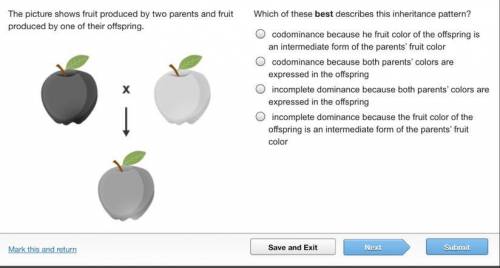The picture shows fruit produced by two parents and fruit produced by one of their offspring.
...

Biology, 05.05.2020 23:01 wannaoneisforever
The picture shows fruit produced by two parents and fruit produced by one of their offspring.
Which of these best describes this inheritance pattern?
codominance because he fruit color of the offspring is an intermediate form of the parents’ fruit color
codominance because both parents’ colors are expressed in the offspring
incomplete dominance because both parents’ colors are expressed in the offspring
incomplete dominance because the fruit color of the offspring is an intermediate form of the parents’ fruit color


Answers: 1


Other questions on the subject: Biology

Biology, 21.06.2019 19:30, tayacall9362
The body is protected against harmful flu viruses by
Answers: 1

Biology, 22.06.2019 08:00, cailinhannon4828
Punnett squares are used to show possible combinations of alleles or to predict the probability of a trait occurring in offspring. an incomplete dominance cross is performed between a bird that is homozygous for red feathers and a bird that is homozygous for blue feathers. purple offspring result. then, two of the purple offspring are crossed. according to the punnett square for this cross, how many of the offspring from the second cross will have a feather color that results from incomplete dominance? 1 in 4 2 in 4 3 in 4 4 in 4
Answers: 2

Biology, 22.06.2019 08:30, malumnugget
Scientists discover two populations of mice on either side of a major river. the two populations have almost identical genes but the mice from one side cannot breed with mice from the other. this is most likely because
Answers: 2

Biology, 22.06.2019 09:30, ssuereichard
You have just sequenced a new protein found in mice and observe that sulfur-containing cysteine residues occur at regular intervals. what is the significance of this finding? it will be important to include cysteine in the diet of the mice. cysteine residues are required for the formation of α helices and β pleated sheets. cysteine residues are involved in disulfide bridges that form tertiary structure. cysteine causes bends, or angles, to occur in the tertiary structure of proteins.
Answers: 1
You know the right answer?
Questions in other subjects:

Mathematics, 21.08.2019 18:30

History, 21.08.2019 18:30



Mathematics, 21.08.2019 18:30


Biology, 21.08.2019 18:30



Social Studies, 21.08.2019 18:30



